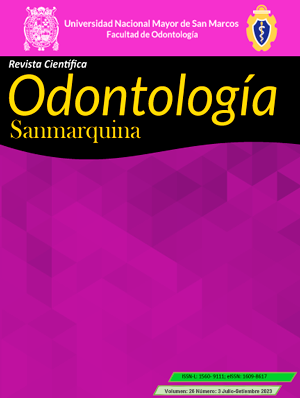Low frequency laser for major recurrent aphthous stomatitis. Clinical case
DOI:
https://doi.org/10.15381/os.v26i3.25337Keywords:
LLLT, Aphthous Stomatitis, Mouth MucosaAbstract
Recurrent aphthous stomatitis (minor, major or herpetic) is one of the most frequent bucodental diseases, of multifactorial etiology and with genetic predisposition. The diagnosis of this pathology is clinical, and based on the clinical history it can be discriminated with other ulcerative pathologies. Low power laser therapy (LLLT) is proposed as a non-invasive treatment, acting as a cellular photo modulator, which reduces pain, inflammation, and stimulating tissue regeneration, preventing damage. This article reports an 11-year-old boy with a 4-month-old painful wound on the posterior edge of the tongue that appeared after a bite, in which clinical examination revealed a yellowish lesion with reddened areas, surrounded by a whitish halo with rounded edges. LLLT was used for the treatment, after one week the pain decreased, the patient started to eat properly, after 15 days a reduction of the reddish edges of the lesion was observed, after one month the lesion had almost completely remitted. LLLT is described as an effective, non-invasive treatment, which reduces symptoms and improves the patient’s quality of life promoting the healing of the lesions.
Downloads
Downloads
Published
Issue
Section
License
Copyright (c) 2023 Antonieta Perez-Flores, Carolina Ruiz, Claudia Fierro-Monti

This work is licensed under a Creative Commons Attribution 4.0 International License.
AUTHORS RETAIN THEIR RIGHTS:
a. Authors retain their trade mark rights and patent, and also on any process or procedure described in the article.
b. Authors retain their right to share, copy, distribute, perform and publicly communicate their article (eg, to place their article in an institutional repository or publish it in a book), with an acknowledgment of its initial publication in the Odontología Sanmarquina.
c. Authors retain theirs right to make a subsequent publication of their work, to use the article or any part thereof (eg a compilation of his papers, lecture notes, thesis, or a book), always indicating the source of publication (the originator of the work, journal, volume, number and date).




















